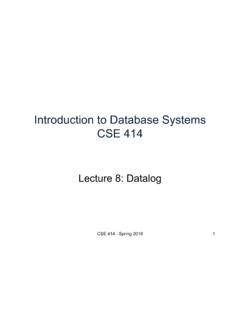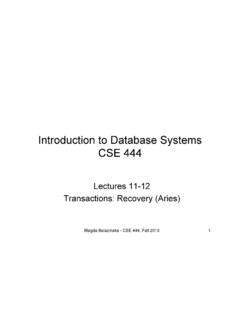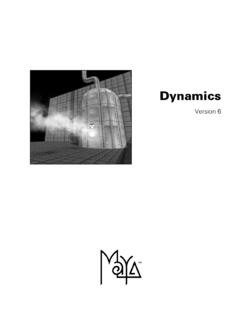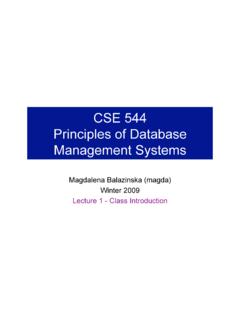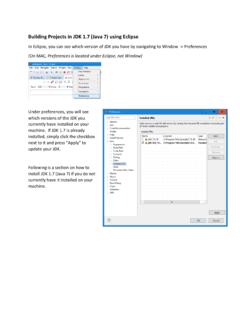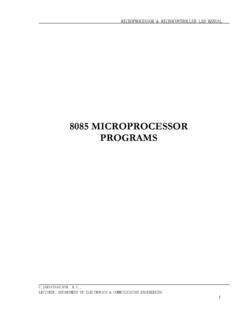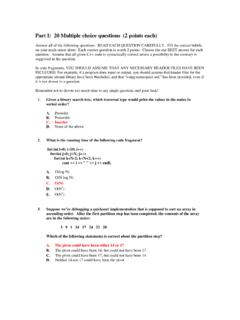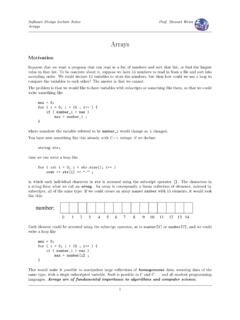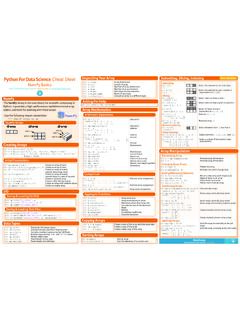Transcription of Part I: 22 Multiple choice questions (2 points each)
1 Part I: 22 Multiple choice questions (2 points each) Answer all of the following questions . READ EACH QUESTION CAREFULLY. Fill the correct bubble on your mark-sense sheet. Each correct question is worth 2 points . Choose the one BEST answer for each question. Assume that all given C++ code is syntactically correct unless a possibility to the contrary is suggested in the question. Remember not to devote too much time to any single question, and good luck! Suppose we need to sort a list of employee records in ascending order , using the social security number (a 9-digit number) as the key ( , sort the records by social security number). If we need to guarantee that the running time will be no worse than n log n, which sorting methods could we use? A. mergesort B. quicksort C. insertion sort D. Either mergesort or quicksort 1. E. None of these sorting algorithms guarantee a worst-case performance of n log n or better Consider the following function f: int f(int n) { int s = 0; while(n > 1) { n = n/2; s++; } return s; } What is the asymptotic complexity of f in terms of n?
2 (Pick the smallest correct answer) A. )log(nnO B. )(nO C. )(nO D. )(lognO 2. E. )(2nO CSE 143 2000WI Final Exam Version B Page 2 of 16 The most important reason for including a destructor in a class is: A. To print a message for debugging purposes B. To store information about an object before it goes out of scope C. To free up resources allocated by that class D. To reset the original object s pointer to NULL 3. E. To make your TA happy One of these code fragments calls the copy constructor for class A. Which one? (Assume that doSomething is a void function with a parameter of the appropriate type.) A. A a; B b; a = b; B. A array[20]; C. A a; doSomething(a); D. A* a; doSomething(a) 4. E. A a; doSomething( Consider a class List that implements an unordered list. Suppose it has as its representation a singly linked list with a head and tail pointer ( , pointers to the first and last nodes in the list).)
3 Given that representation, which of the following operations could be implemented in O(1) time? I. Insert item at the front of the list II. Insert item at the rear of the list III. Delete front item from list IV. Delete rear item from list A. I and II B. I and III C. I, II, and III D. I, II, and IV 5. E. all of them CSE 143 2000WI Final Exam Version B Page 3 of 16 What output does this C++ program produce? #include <iostream> using namespace std; class Bird { public: virtual void noise( ); }; void Bird::noise( ) { cout << "chirp "; } //-------------------------------------- --- class Duck: public Bird { public: virtual void noise( ); }; void Duck::noise( ) { cout << "quack "; } //-------------------------------------- --- class Goose: public Bird { public: virtual void noise( ); }; void Goose::noise( ) { cout << "honk "; } //-------------------------------------- --- int main() { Bird tweety; Goose ralph; Duck donald; tweety = donald; ( ); ( ); ( ); return 0; } A.
4 Chirp quack honk B. quack quack honk C. chirp chirp honk D. chirp chirp chirp 6. E. The program won t compile because the variable types in the assignment statement aren t compatible CSE 143 2000WI Final Exam Version B Page 4 of 16 Consider a class List that implements an unordered list. Suppose it has as its representation a dynamically expanding (resizeable) array. Which of these operations might need to delete some dynamically allocated storage to avoid a memory leak? I. Default Constructor II. Copy Constructor III. Destructor IV. Assignment operator A. I and II B. II and III C. II and IV D. III and IV 7. E. II, III, and IV What is the postfix representation of this expression? (12 a) * (b + 9) / (d * 4) A. 4 b * d 9 + a 12 - * / B.
5 / 12 a b 9 + d 4 * C. 12 a * b + 9 / d * 4 D. 12 a b 9 + * d 4 * / 8. E. None of the above What is the asymptotic runtime for traversing all nodes in a binary search tree with n nodes and printing them in order ? A. ))log((nnO B. )(nO C. )(nO D. ))(log(nO 9. E. )(2nO CSE 143 2000WI Final Exam Version B Page 5 of 16 Here is a binary tree. 1 / \ 2 6 / \ / \ 4 9 3 7 / \ 8 5 If we visit the nodes of this tree using a preorder traversal, in what order will the nodes be visited? A. 1 2 3 4 5 6 7 8 9 B. 1 2 4 9 6 3 8 5 7 C. 4 9 2 8 5 3 7 6 1 D. 4 2 9 1 8 3 5 6 7 1 2 6 4 9 3 7 8 5 On your answer sheet, which test version is marked in the box to the right of your student number? (You may mark the correct version before you answer this question if you haven t done so already.)
6 A. A B. B C. C D. D E Assuming that the hash function for a table works well, and the size of the hash table is reasonably large compared to the number of items in the table, the expected (average) time needed to find an item in a hash table containing n items is A. )1(O B. )(lognO C. )log(nnO D. )(nO )(nO If an internet router is receiving packets faster than it can forward them to the next location on the network, the router will A. Return the packets to the sender, and the sender will retransmit them later B. Store the packets locally and forward them when the next router indicates it is ready to accept more traffic C. Discard the packets, , drop them on the floor D. The router will reboot itself, because this is never supposed to happen None of the above CSE 143 2000WI Final Exam Version B Page 6 of 16 Here is a simple class and a short program that uses it.
7 To save space, the method implementations are included in the class declaration, instead of being written separately (this is legal C++, even if not always the best style). #include <iostream> using namspace std; class X { private: int *data; // data array public: X() { data = new int[100]; } ~X() { delete [ ] data; } void set(int loc, int val) { data[loc] = val; } int get(int loc) { return val; } }; int main( ) { X a; X b; int k; (4,12); (12,17); b = a; k = (4); cout << k; } What happens when this program is executed? A. The program executes without any errors and prints 12 B. The program won t compile, because X does not define assignment for objects of class X ( , does not contain an operator= method), so the assignment b = a; is not allowed here C. The program won t compile, because X does not contain a copy constructor, so the assignment b = a; is not allowed here D.
8 The program may crash because it uses new and/or delete incorrectly The program executes incorrectly because (4) refers to an uninitialized variable, so the value assigned to k will be garbage CSE 143 2000WI Final Exam Version B Page 7 of 16 Members of a class can be public, private, or protected. What does it mean for a member of a class to be protected? I. The member can be directly accessed in member functions belonging to that class II. The member can be directly accessed in member functions belonging to classes derived from the original class III. The member can be accessed from functions that are not members of the original or derived classes A. I only B. II only C. III only D. I and II I, II, and III Which of the following is not a key fact or rule of thumb about Computer Science? A. 210 = 1024 B. 1 + 2 + .. + n = n(n+1)/2 C.
9 The answer is it depends D. Computer Science students should get at least 8-10 hours of sleep every night, and they normally do Ask not what an object can do for you, ask what it can do to itself. A variable named this is automatically available in every member function of a class and does not need to be declared explicitly. Inside a member function for a class X, what is the type of the variable this? A. X B. X* C. X& D. void* Something else CSE 143 2000WI Final Exam Version B Page 8 of 16 Here are a couple of related class declarations (implementations omitted). class Base { public: Base(); ~Base(); void f(int k); void f(double x[ ]); int g(double y); }; class Extended: public Base { Extended(); ~Extended(); void f(int w); int g(double v[ ]); }; What is the relationship between the declaration of function f in class Extended and the declarations of f in class Base?
10 A. Extended::f overloads both definitions of f in Base B. Extended::f overloads only Base::f(int k) C. Extended::f overrides both definitions of f in Base D. Extended::f overrides only Base::f(int k) This program will not compile because there is only one definition of f in Extended; to fix the problem, Extended would need to contain both a definition of f with an int parameter and a second definition of f with a double array parameter. Java supports dynamic storage allocation with new, but it does not provide an explicit delete operator like the one found in C++. Why not? A. Java programs are small and never execute long enough to run out of memory during execution. So there is no need to reclaim unused storage until the program finishes. B. Since Java is designed to run efficiently on small, embedded computers, the overhead required to implement delete is unacceptable.


